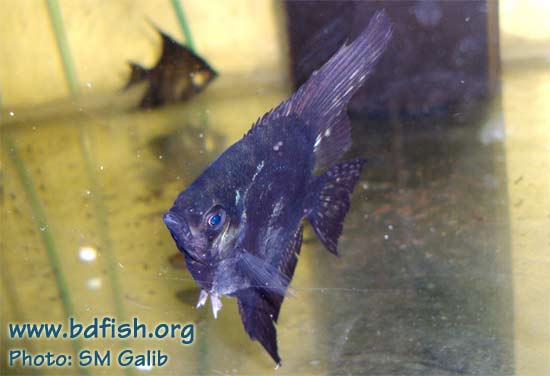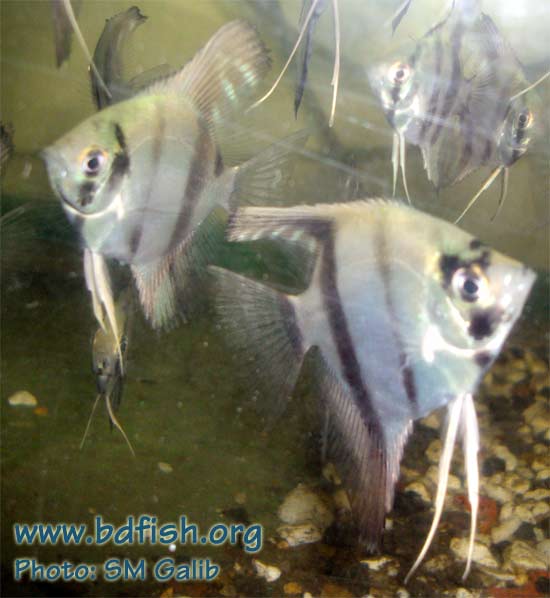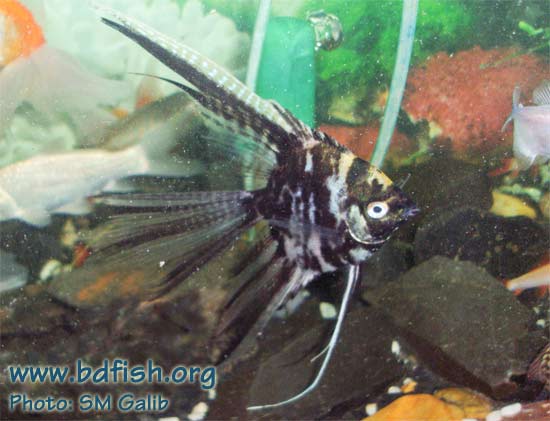
The angelfish is a very popular tropical fish because of its unique shape and interesting personalities (Galib and Mohsin, 2011). This fish is naturally found in Amazon River, Africa and Guinea (Shammi and Bhatnagar, 2002; Saxena, 2003). Life span is 8 to 10 years (Fishlore, 2010).
Systematic position
Phylum: Chordata
Class: Actinopterygii (Ray-finned fishes)
Order: Perciformes (Perches)
Suborder: Elassomatoidei
Family: Cichlidae (Cichlids)
Genus: Pterophyllum
Species: P. scalare
Varieties available in Bangladesh
Black angel: completely black colored.
Marble angel: Blackish body with irregular whitish or yellowish or brown color.
Silver angel: Silvery body with black several vertical black or blackish bands on eyes and body.
White angel: Pure white in color.

Synonyms
Platax scalaris Cuvier and Valenciennes, 1831
Plataxoides dumerilii Castelnau, 1855
Pterophyllum dumerilii (Castelnau, 1855)
Pterophyllum eimekei Ahl, 1928
Zeus scalaris Schultze, 1823
Common/local names
English: Angel, Black angel, Marble angel, Silver angel and White angel
Bangladesh: Angel
Morphology: Body strongly compressed. The fins exhibiting unusual feature such as existence of thread filaments arising from the top and bottom rays of the tail fin, first fin ray of dorsal and ventral fins and also of pectoral fins. The long dorsal and anal fins spread gracefully like the wings of a bird.
Body color silvery, reflecting tints of blue, has many small speckles not unlike freckles. Evenly spaced black vertical bar’s stripe, the body the first one through the eye, the last across the caudal preduncle. One of the body strips continues into fins.
SL and FL 45.56-68.57% of TL, BD 32.22-50.00% of TL, HL 18.89-30.00 of TL, CP 3.33-5.71% of TL and Eye 23.53-28.57% of HL (Galib and Mohsin, 2011).

Maximum length: 5 inches (12.7 cm) (Saxena, 2003).
Food and feeding: Chiefly a carnivore and slow moving fish, prefers floating feeds (Galib and Mohsin, 2011).
Spawning: No breeding was recorded in Bangladesh.
Sexing: There are no visible differences between the male and female and only at spawning, female develops a round “tear-drop” shaped breeding tube and a male has a cone shaped breeding tube (Galib and Mohsin, 2011). The female has a large vent and tube extending from the vent during spawning is twice the diameter of that of male (Thomas et al., 2003).
Fishery info: Used as ornamental fish in aquarium. Very popular species.
__________________________________________________________
REFERENCES
Ahl E (1928) Übersicht über die Fische der südamerikanischen Cichliden-Gattung Pterophyllum. Zoologischer Anzeiger 76:251-255.
Castelnau FL (1855) Poissons. In: Animaux nouveaux or rares recueillis pendant l’expédition dans les parties centrales de l’Amérique du Sud, de Rio de Janeiro a Lima, et de Lima au Para; exécutée par ordre du gouvernement Français pendant les années 1843 a 1847 2:1-112.
Cuvier G and Valenciennes A (1831) Histoire naturelle des poissons. Tome septième. Livre septième. Des Squamipennes. Livre huitième. Des poissons à pharyngiens labyrinthiformes. Histoire naturelle des poissons. 7:1-531.
Fishlore (2010) FishLore.com Tropical Fish Information, retrieved on January 01, 2010; http://www.fishlore.com/Profiles-Angelfish.htm
Saxena A (2003) Aquarium Management, Daya Publishing House, Delhi 110035, India, 230 pp.
Shammi QJ and Bhatnagar S (2002) Applied Fisheries, Published by Agrobios (India), Agro House, Behind Nasrani Cinema, Chopasani Road, Jodhpur 342 002, India, 328 pp.
Thomas PC, Rath SC and Mohapatra KD (2003) Breeding and Seed Production of Fin Fish & Shell Fish (Foreword by Dr. T.V.R. Pillay), Daya Publishing House, Delhi 110035, India, 377 pp.
Visited 2,008 times, 1 visits today | Have any fisheries relevant question?
